◄ Carnets Geol. 14 (18) ►
Contents
[1. Introduction]
[2. Review of past lithostratigraphic information and new definition]
[3. Biostratigraphic review]
[4. Review of paleontological data]
[5. New microfossil data]
[6. Correlations]
[7. Conclusion] [Bibliographic references] and ... [Plates]
Université de Bretagne Occidentale (UBO), UMR 6538 Domaine
Océanique, 6 avenue Le Gorgeu - CS 93837, 29238 Brest Cedex 3 (France)
Department of Ecology and Evolutionary Biology, The University of Kansas, 1200 Sunnyside Avenue, Lawrence, Kansas 66045 (USA)
Lebanese University, Faculty of Science II, Fanar, Natural Sciences Department, Fanar -
El-Matn, P.O. Box 26110217
(Lebanon)
Lebanese University, Faculty of Science II, Fanar, Natural Sciences Department, Fanar - El-Matn, P.O. Box 26110217 (Lebanon)
GEGENA2 EA 3795, UFR de Sciences exactes et naturelles, Université de
Reims, 2 esplanade Roland-Garros, 51100 Reims (France);
present address: 5 rue du Moulin Rouge, 77140 Saint-Pierre-lès-Nemours (France)
Instituto de Geología, Universidad Nacional Autónoma de México, Ciudad Universitaria, Coyoacán, 04510,
México, D.F. (Mexico)
Published online in final form (pdf) on November 14, 2014
[Editor: Robert W. ; technical editor: Bruno ]
The "Falaise de " is a prominent cliff, consisting mostly of Lower Cretaceous limestones that extends as linear outcrops over most of the Lebanese territory and provides geologists a remarkable reference for stratigraphic studies. However, until now, this unit was lacking a clear definition. We introduce herein the Jezzinian Regional Stage, the type-locality of which is at Jezzine. It equates as an unconformity-bounded unit and, per definition, it is framed by two discontinuities. Because we identified an additional, median sequence-boundary, poorly-expressed in the type-section but better at Aazour, only 4.5 km westward of Jezzine, the new regional stage implicitly spans two sequences. The lithostratigraphic framework being properly redefined, we were able to investigate time-constrained micropaleontological assemblages, consisting mostly of benthic foraminifers and calcareous algae. Typically Southern Tethysian, these assemblages contribute to high-resolution, holostratigraphic correlations with the Persian Gulf area, on the eastern part of the Arabian Plate. The Jezzinian interval correlates with the upper part of the Kharaibian Regional Stage (also known as "Thamama II" reservoir unit in the oil industry). In turn, the Jezzinian is indirectly correlated with the Northern Tethysian Urgonian stratigraphic units where it corresponds to a rather short interval encompassing the standard Barremian - Bedoulian stage boundary. Locally the upper discontinuity is associated to a significant intra-Bedoulian hiatus. The macrofossil assemblages found in the Jezzinian (echinids) and above it (ammonites) support, or at least do not contradict, our micropaleontological dating.
Lebanon; Lower Cretaceous; Barremian; Bedoulian; Aptian auct.; Falaise de ; Jezzinian Regional Stage; rudists; echinids; ammonites; foraminifers; Dasycladales.
S., B., D., R., J.-C. & J.A. (2014).- Revision of "Falaise de " (Lower Cretaceous) in Lebanon, with the definition of a Jezzinian Regional Stage.- Carnets de Géologie [Notebooks on Geology], Brest, vol. 14, nº 18, p. 401-427.
Révision de la "Falaise de " (Crétacé inférieur) au Liban et définition de l'Étage Régional Jezzinien.- Les calcaires du Crétacé inférieur de la "Falaise de " affleurent sur une grande partie du territoire libanais. Ils apparaissent dans le paysage sous forme d'escarpements linéaires saillants constituant autant de points d'ancrage remarquables pour tout recalage stratigraphique. Toutefois, jusqu'à très récemment, cette unité était piètrement caractérisée : il lui manquait notamment une définition rigoureuse. Nous introduisons ici l'Étage Régional Jezzinien, dont la localité-type est sise à Jezzine. Il s'agit d'une unité stratigraphique particulière, aussi appelée U.B.U. (pour "unconformity-bounded unit"), une unité qui, par définition, est encadrée par deux discontinuités. Parce que nous avons identifié une limite de séquence supplémentaire, en position médiane, peu exprimée dans la section-type, mais beaucoup mieux à Aazour, à 4,5 km à peine à l'ouest de Jezzine, le nouvel étage régional devrait implicitement couvrir deux séquences. Le canevas lithostratigraphique étant clairement redéfini, nous avons pu étudier les associations micropaléontologiques, constituées essentiellement de foraminifères benthiques et d'algues calcaires, associations dorénavant relativement bien contraintes du point de vue de leur âge. Typiquement sud-téthysiennes, elles facilitent les corrélations holostratigraphiques à haute résolution avec la région du Golfe persique, sur le côté oriental de la Plaque arabique. L'intervalle Jezzinien correspond ainsi à la partie supérieure de l'Étage Régional Kharaibien (aussi connu comme unité réservoir "Thamama II" dans l'industrie pétrolière). À son tour, le Jezzinien est indirectement corrélé avec les unités stratigraphiques urgoniennes nord-téthysiennes où il correspond à un intervalle relativement court comprenant la limite des étages standards (internationaux) Barrémien et Bédoulien. Localement la discontinuité sommitale est associée à un hiatus intra-Bédoulien significatif. Les associations macropaléontologiques reconnues dans le Jezzinien (échinides) et au-dessus de cette unité (ammonites) viennent à l'appui de notre datation micropaléontologique ou tout au moins ne la contredisent pas.
Liban ; Crétacé inférieur ; Barrémien ; Bédoulien ; Aptien auct. ; Falaise de ; Étage Régional Jezzinien ; rudistes ; échinides ; ammonites ; foraminifères ; Dasycladales.
The "Falaise de " is a sheer-sided limestone cliff of alleged Aptian sensu lato (Bedoulian - "Gargasian") age that trends throughout the chains of Mount
Lebanon, Anti-Lebanon (Lebanon:
Fig. 1 ![]() ), Southern Alawite Mountains
(Syria) and northern Galilee. This distinctive geomorphological unit forms the natural bridge of Fakra-Kfardebiane
(Fig. 2
), Southern Alawite Mountains
(Syria) and northern Galilee. This distinctive geomorphological unit forms the natural bridge of Fakra-Kfardebiane
(Fig. 2 ![]() ) and the background of the waterfalls at Jezzine
(Fig. 3
) and the background of the waterfalls at Jezzine
(Fig. 3 ![]() ), where it is some 70 meters in
height. Actually (1955: p. 20) was the first to attempt - unsuccessfully - to re-label it as "Falaise de Djezzine" after the name of this last
locality. This stratigraphical unit required a full re-evaluation as, for instance,
(1942) and later
(1947) stated that it consists of a "calcaire récifal blanc" [a white reefal
limestone], an assumption that is not consistent with our field observations and the scarcity of
corals. Furthermore, it was lacking a type-locality and clear definitions of its lower and upper
boundaries. Finally, there are also many interpretations regarding its dating:
(1963) claimed a late Aptian (= "Gargasian") age for his unit "c2b" (op. cit.: p. 43: "depuis la muraille de jusqu'à la base des bancs à Cardium") while the fossiliferous strata below
it, i.e., his unit c2a, should be early Aptian (= Bedoulian) in age; on the other hand,
(1970), without excluding a late Aptian age for the uppermost
layers, assumed its mainly early Aptian age. However due partly to the recent updates in the definitions and our understanding of the Barremian
[1], Bedoulian and Aptian
[2] stages and substages in their historical stratotypic areas these old datings should be fully
reconsidered.
), where it is some 70 meters in
height. Actually (1955: p. 20) was the first to attempt - unsuccessfully - to re-label it as "Falaise de Djezzine" after the name of this last
locality. This stratigraphical unit required a full re-evaluation as, for instance,
(1942) and later
(1947) stated that it consists of a "calcaire récifal blanc" [a white reefal
limestone], an assumption that is not consistent with our field observations and the scarcity of
corals. Furthermore, it was lacking a type-locality and clear definitions of its lower and upper
boundaries. Finally, there are also many interpretations regarding its dating:
(1963) claimed a late Aptian (= "Gargasian") age for his unit "c2b" (op. cit.: p. 43: "depuis la muraille de jusqu'à la base des bancs à Cardium") while the fossiliferous strata below
it, i.e., his unit c2a, should be early Aptian (= Bedoulian) in age; on the other hand,
(1970), without excluding a late Aptian age for the uppermost
layers, assumed its mainly early Aptian age. However due partly to the recent updates in the definitions and our understanding of the Barremian
[1], Bedoulian and Aptian
[2] stages and substages in their historical stratotypic areas these old datings should be fully
reconsidered.
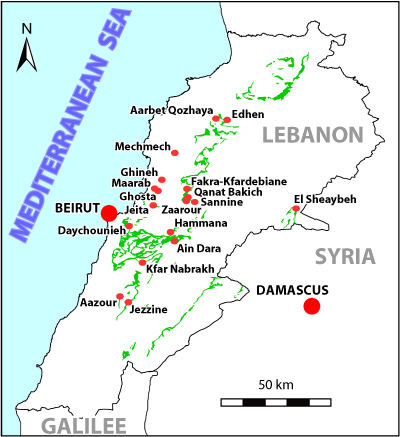
Click on thumbnail to enlarge the image.
Figure 1: A simplified map of Lebanon showing the Jezzinian Regional Stage in green. Localities cited in the publication:
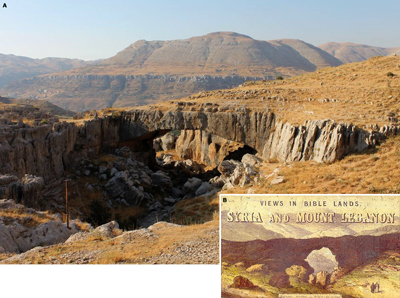
Click on thumbnail to enlarge the image.
Figure 2: The natural bridge of Fakra-Kfardebiane. A: Nowadays view; B: Front cover of a XIXth Century edition of the book "Views in Bible lands. Syria and Mount Lebanon".
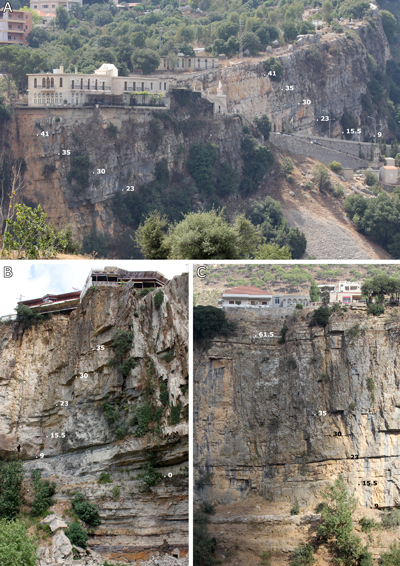
Click on thumbnail to enlarge the image.
Figure 3:
The cliff at Jezzine and Wadi Jezzine. A:
The eastern side with the road section
(see Log ![]() );
B: The waterfall and the lower boundary at 0 m; C: The western side and the upper boundary at 61.5 m. Number labels refer to the metrics from the road section.
);
B: The waterfall and the lower boundary at 0 m; C: The western side and the upper boundary at 61.5 m. Number labels refer to the metrics from the road section.
After summing up the notes of earlier authors (, 1847; , 1878; , 1886; , 1910, 1913; , 1926; , 1934, 1947, 1955, 1963; & , 1937; , 1970, 1972), we propose herein a new holostratigraphic definition for this unit, i.e., a definition based on our faciological, lithostratigraphical, sequential, and paleontological analyses. The microfossil assemblages are compared with those of the Persian Gulf, because both areas belong to the same tectonic plate, i.e., the Arabian Plate.
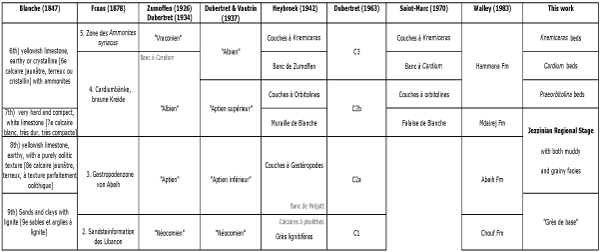
Click on thumbnail to enlarge the image.
Table 1: Summary of the attributed terminology to the Jezzinian and its surrounding units over the period 1847 to date.
The discrete geological/morphological unit corresponding to
"Falaise de " was named by
(1910) after Charles-Isidore (1823-1887). According to
(1847, p. 14-15), it consists of "8º Un calcaire jaunâtre, terreux, à texture parfaitement oolithique" [8th) A yellowish
limestone, earthy, with a purely oolitic texture], below, and "7º (...) un calcaire blanc, très dur, très compacte, à grain extrêmement fin et presque cristallin" [7th) a very hard and compact, white micritic
limestone], above (Table 1 ![]() ) [Note that described the section from top to
bottom]. This unit represents the "Gastropodenzone von Abeih" of
(1878), sandwiched between his "Sandsteinzone des Libanon" below and his "Braune Kreide
(Cardiumbänke)" above. In 1963, for the edition of the "Lexique Stratigraphique International", re-labelled the Gastropodenzone
as "Falaise de Mdairej" and the Sandsteinzone as "Grès de Base".
Unfortunately, for the neighborhoods of Beirut, he introduced an unnamed transitional zone (op. cit.: p. 56) consisting of "170 m de terrains argilo-sableux et calcaires fossilifères" [170 m of shaley to sandy and fossiliferous calcareous
strata] between "Falaise de Mdairej" and "Grès de Base". 's "revision"
(1983) merely introduced new names for the old units
(from base to top "Chouf Sandstone Formation", "Mdairej Formation", and "Hammana Formation").
However, he failed to give clear definitions for most of these newly re-labelled lithostratigraphic units and he even added more confusion as, for instance, he ascribed a formal name to 's transitional unit (i.e., "Abeih Formation") without providing any data supporting its distinctiveness among the Lebanese Cretaceous formations
(Table 1
) [Note that described the section from top to
bottom]. This unit represents the "Gastropodenzone von Abeih" of
(1878), sandwiched between his "Sandsteinzone des Libanon" below and his "Braune Kreide
(Cardiumbänke)" above. In 1963, for the edition of the "Lexique Stratigraphique International", re-labelled the Gastropodenzone
as "Falaise de Mdairej" and the Sandsteinzone as "Grès de Base".
Unfortunately, for the neighborhoods of Beirut, he introduced an unnamed transitional zone (op. cit.: p. 56) consisting of "170 m de terrains argilo-sableux et calcaires fossilifères" [170 m of shaley to sandy and fossiliferous calcareous
strata] between "Falaise de Mdairej" and "Grès de Base". 's "revision"
(1983) merely introduced new names for the old units
(from base to top "Chouf Sandstone Formation", "Mdairej Formation", and "Hammana Formation").
However, he failed to give clear definitions for most of these newly re-labelled lithostratigraphic units and he even added more confusion as, for instance, he ascribed a formal name to 's transitional unit (i.e., "Abeih Formation") without providing any data supporting its distinctiveness among the Lebanese Cretaceous formations
(Table 1 ![]() ).
).
The lithostratigraphic approach of (as that of ) is essentially facies-driven:
1) grain-dominated, shoal facies (oolitic and bioclastic wackestones and grainstones) are referred to the Abeih Formation;
2) mud-dominated, lagoonal facies (mudstones and bioclastic
wackestones, with some gastropod floatstones) to the "Falaise de " or Mdairej Formation
(Table 1 ![]() ).
(1947) described it as "calcaire blanc récifal"
[white reef limestone] (, 1963: p. 44), but there is no evidence of a reef
environment. (1963) named it "Falaise de Mdairej" after he established its type-section in this
locality. Nowadays, the section is no longer available because of recent
urbanization.
).
(1947) described it as "calcaire blanc récifal"
[white reef limestone] (, 1963: p. 44), but there is no evidence of a reef
environment. (1963) named it "Falaise de Mdairej" after he established its type-section in this
locality. Nowadays, the section is no longer available because of recent
urbanization.
The micritic facies ("Mdairej") are commonly found in the upper part of most sections, above the calcarenitic facies ("Abeih"). They may locally be missing or interfinger with the later, suggesting that these areas represent transition zones between a shoal barrier and a protected lagoon behind it. This geometrical relationship is merely the signature of regular lateral changes in facies within a single time-unit. In addition, the orbitolinid and algal assemblages are very similar in both of these units. Rather than using the obsolete and meaningless facies-driven units, we have adopted the concepts of "Unconformity Bounded Unit", i.e., UBU, or Alloformation ( & , 1999; see , 2000, for application in the Middle East), or "Regional Stage" (see et al., 2011).
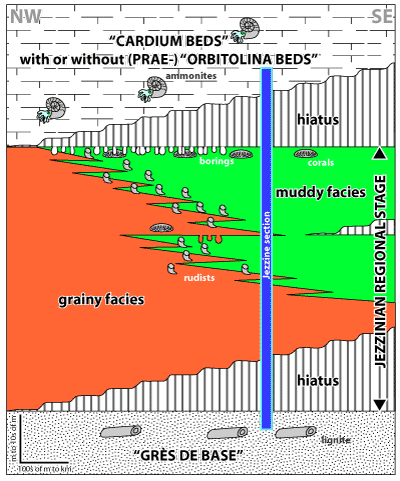
Click on thumbnail to enlarge the image.
Figure 4: Lithostratigraphic scheme of the Jezzinian Regional Stage showing the two bounding sequence boundaries (SB) - transgressive surfaces (TS). For a simplification purpose, each hiatus does not take erosion in consideration, but only non-deposition. Similarly, the median boundary and the associated hiatus are not illustrated.
The term "Falaise de " is obviously ambiguous; first because some authors confused this unit with the "Cardium Beds" and others ignored the grainy facies that should be included, second because the term describes a geomorphological feature rather than a stratigraphic unit. Hence, we selected Jezzine
(Jezzine District, South Governorate, Lebanon) as the most representative locality to define the Jezzine UBU, Jezzine Alloformation and Jezzinian Regional Stage, all of these terms being synonymous in our understanding
(Fig. 4 ![]() ), as the interval having:
), as the interval having:
1) the lower boundary corresponding to the sequence boundary at the top of the siliciclastic coastal and estuarine deposits of the "Grès de Base". This paleoenvironmental interpretation is suggested by the occurrence of marine bivalves in bioturbated sands and shales, in association with lignite. At the Jezzine waterfall, the boundary, which is amalgamated with a transgressive surface at the top of the underlying siliciclastic unit, occurs
directly above a lignite-rich horizon
(Figs. 3.A-B ![]() :
0, and 5
:
0, and 5 ![]() ). "Floated" amber clasts found in such lignite-rich levels yield numerous biological inclusions, mostly Early Cretaceous arthropod remains (,
1997; et al., 2010), previously thought to be Bedoulian-Aptian in age (et al., 2003). Not far from Jezzine, outcrops
have charophyte remains ( & ,
1968; , 1972; note: the material was originally collected by ,
1965),
which in places are associated with the Triploporellacean alga Salpingoporella dinarica
(, 1959) and the foraminifer Choffatella gr. decipiens , 1905 ( et al., work in progress);
). "Floated" amber clasts found in such lignite-rich levels yield numerous biological inclusions, mostly Early Cretaceous arthropod remains (,
1997; et al., 2010), previously thought to be Bedoulian-Aptian in age (et al., 2003). Not far from Jezzine, outcrops
have charophyte remains ( & ,
1968; , 1972; note: the material was originally collected by ,
1965),
which in places are associated with the Triploporellacean alga Salpingoporella dinarica
(, 1959) and the foraminifer Choffatella gr. decipiens , 1905 ( et al., work in progress);
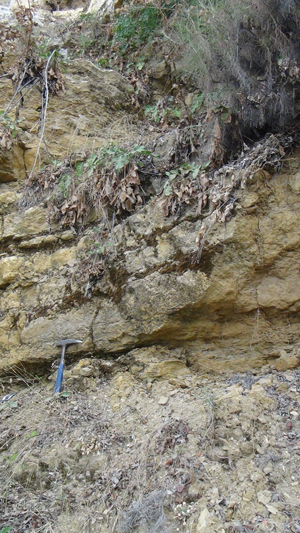
Click on thumbnail to enlarge the image.
Figure 5: Lignite horizon below the transgressive surface on the main road section at the entrance of Jezzine (hammer for scale).
2) the upper boundary corresponding to another sequence boundary at the top of the muddy facies. In Jezzine, it is also amalgamated with a transgressive surface; the next sequence starts with a bioclastic orbitolinid-rich
limestone (Fig. 3.C ![]() :
61.5). In other localities, these bioclastic limestones may be missing and a marly facies with orbitolinids and eventually scattered ammonites is found lying directly above the micritic limestones.
In some places coral colonies are concentrated in strata lying below this upper boundary and locally emersion evidences (fenestrae, casts or molds of former aragonitic bioclasts filled with sediment) are found there too. The surface itself may be encrusted by oysters and bored by worms and pholadids
(Fig. 6.A-B, D & G-F
:
61.5). In other localities, these bioclastic limestones may be missing and a marly facies with orbitolinids and eventually scattered ammonites is found lying directly above the micritic limestones.
In some places coral colonies are concentrated in strata lying below this upper boundary and locally emersion evidences (fenestrae, casts or molds of former aragonitic bioclasts filled with sediment) are found there too. The surface itself may be encrusted by oysters and bored by worms and pholadids
(Fig. 6.A-B, D & G-F ![]() ), indicative of an early lithification of the muddy sediment.
), indicative of an early lithification of the muddy sediment.
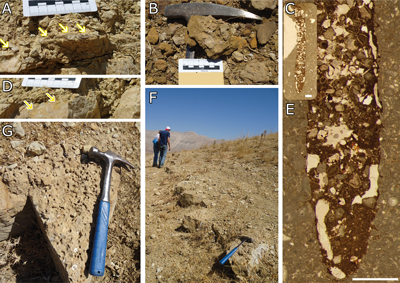
Click on thumbnail to enlarge the image.
Figure 6: Perforations from different localities. A: Ghineh, Oysters (arrows); B: Sannine; C & E: Aarbet Qozhaya, thin-section AAR18.3 (graphic scale = 1 mm); D: Ghineh, borings (arrows); F-G: Zaarour (hammer for scale).
At Jezzine, we measured the
type-section on the side of the main road at the entrance to the town (Fig.
3.A ![]() ). There it is more than 48 m thick
(Log
). There it is more than 48 m thick
(Log ![]() )
because it
reaches some 61.5 m (estimated) in the nearby cliff section at Wadi Jezzine
(Fig. 3.B-C
)
because it
reaches some 61.5 m (estimated) in the nearby cliff section at Wadi Jezzine
(Fig. 3.B-C ![]() ).
The detail of the section will be the main topic of a forthcoming publication. It
is worth mentioning that in Jezzine area muddy facies dominates over grainy facies. On the
opposite, in other localities (for instance, in Aazour, only 4.5 km WNW of Jezzine, or at Aarbet
Qozhaya: Fig. 1
).
The detail of the section will be the main topic of a forthcoming publication. It
is worth mentioning that in Jezzine area muddy facies dominates over grainy facies. On the
opposite, in other localities (for instance, in Aazour, only 4.5 km WNW of Jezzine, or at Aarbet
Qozhaya: Fig. 1 ![]() ),
grainy facies dominates over muddy facies. In these localities the occurrence of
a muddy "tongue" in the grainy facies led us to identify a median unconformity on top of
the muddy "tongue": at Aarbet Qozhaya, it consists of a burrowed and bored surface (Figs. 6.C&E
),
grainy facies dominates over muddy facies. In these localities the occurrence of
a muddy "tongue" in the grainy facies led us to identify a median unconformity on top of
the muddy "tongue": at Aarbet Qozhaya, it consists of a burrowed and bored surface (Figs. 6.C&E ![]() and 7
and 7 ![]() ),
and therefore to discriminate two Jezzinian subunits/sequences.
),
and therefore to discriminate two Jezzinian subunits/sequences.
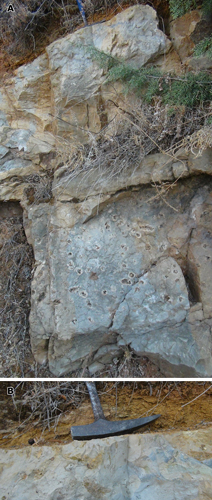
Click on thumbnail to enlarge the image.
Figure 7:
A:
Top of the lowest of the two Jezzinian sequences at Aarbet Qozhaya. One
of the two massive beds contains numerous shells of "geant" nerinid
gastropods; B: Detail of the burrowed and bored surface
(Fig. 6.C&E ![]() )
at the top of the
micritic interval (hammer for scale).
)
at the top of the
micritic interval (hammer for scale).
Having identified the key facies and defined the lithostratigraphical and sequential framework, we can review the fossil contents and biostratigraphic interpretations.
On the basis of macrofossil finds, (1878) proposed the first chronostratigraphic framework for the "Late Cretaceous" Lebanese units. According to (1886), ' succession consisting from base to top of the Sandsteinzonze, the Gastropodenzone and the Cardiumbanke is respectively Cenomanian in age for the first unit and Turonian for the last two.
According to (1910) and (1934), the mud-dominated facies of "Falaise de " should be referred to the Albian. However actually, some age-diagnostic fossils were collected by a third person from a discrete cliff located above the "Falaise de ", i.e., "Falaise de " [see discussion below]. In his later publications, ( & , 1937; , 1955, 1963) ascribed this facies to the "Aptien supérieur" (i.e., Aptian auct.). He mentioned some macrofossils (echinids, rudists and pelecypods) and few microfossils (orbitolinids). (1970) was the first to base his dating mainly on micropaleontological data. He identified several benthic foraminifers and calcareous algae that led him to ascribe the "Falaise de " an Aptian age: both "inférieur" (early, i.e., Bedoulian), most of it actually, and "supérieur" (late, i.e., Aptian auct.), as he did not exclude this dating at least for the uppermost strata. The overlying "couches à Orbitolines" (Orbitolina Beds), an unformal unit he introduced (, 1970), can be treated either as part of the Cardium Beds of previous authors or as a junior synonym.
Since 1910 many fossil finds have been reported in the Lebanese literature.
(1910, 1913) identified some rudists from Lebanon but he did not collect the materiel himself. For instance, he identified Polyconites verneuili , 1860 (1913: Pl. IX, figs. 1-3) and Eoradiolites plicatus , 1852 (, 1910: Figs. 71-75; , 1913: Pl. IX, fig. 5) among the specimens collected by (, 1913: p. 409; , 1926) from a small cliff consisting of a compact limestone and misinterpreted as "Falaise de " (, 1963). In fact, this cliff is located above "Falaise de ". Both species, Polyconites verneuili and Eoradiolites plicatus, are known from the Aptian auct. - Albian interval (, 1995; & , 2000).
(1913) also identified Agria marticensis , 1847 (op. cit.: Pl. IX, fig. 4), in material collected by (op. cit.: p. 409) probably from the base of the "Falaise de " and ascribed to the Aptian. Actually, it is not a genuine Agriopleura marticensis as it was re-labelled Agriopleura libanica by (1930; & , 2014).
(1942, p. 44) reported the find of "Toucasia sp." at the "sommet de Muraille de " in Kfer Matta [= Kfarmatta], near Abeih. This record was forgotten by subsequent authors.
The identification and the age of these rudists require revision. In addition new rudistid finds are under evaluation (J.-P. et al., in preparation).
(1878: p. 331) reported Heteraster oblongus (, 1821) in his Cardiumbänke, which was then erroneously ascribed to the Cenomanian. These specimens were described as "Enallaster syriacus" by P. de (1887: Pl. VII, figs. 2-3; Pl. XVI, figs. 2-3). Later and (1937) illustrated this echinid under the name of "Heteraster oblongus race syriaca" (op. cit.: Pl. VI, figs. 5-12; Pl. VII, figs. 1-19) from the "Aptien inférieur". (1942), (1947, 1955, 1963), and (1970) also reported it without illustrating it contrary to the "visual guide" of the "fossils of Lebanon" ( et al., 1995: Pl. XX, figs. 87-88; 1997) where it appears as "Heteraster sp.".
and (1937) illustrated from the "Aptien supérieur" Trochodiadema libanoticum , 1887 (op. cit.: p. 140, Pl. V, figs. 2-3), Salenia scutigera , 1835 (op. cit.: p. 144, Pl. V, figs. 4-5), Holectypus portentosus , 1879 (op. cit.: p. 147, Pl. V, fig. 6), Clitopygus (Echinobrissus) goybeti , 1885 (op. cit.: p. 152, Pl. V, fig. 13), and Toxaster dieneri , 1887 (op. cit.: p. 154, Pl. V, figs. 17-20).
(1955) reported from the "Falaise de " Clitopygus (Echinobrissus) goybeti [now considered as a junior synonym of Nucleopygus roberti (A. , 1848)], and Diplopodia hermonensis without illustrating them.
The nomenclature and the age of these echinids require revision too because either identifications are inaccurate or the location of the studied outcrops are uncertain.
In a preliminary evaluation of our own finds (legit D.A., R.G., B.G., S.M.), B. accurately identified four species:
i) First, the irregular urchin, Heteraster oblongus, is commonly found in most Jezzinian outcrops: Kanat
Bakich
(Pl. 3 ![]() ,
figs. C & E; MHNUL 22797/0001-0007), Kfardebiane (Pl. 3
,
figs. C & E; MHNUL 22797/0001-0007), Kfardebiane (Pl. 3 ![]() ,
figs. D & I; MHNUL 25439/0001-0003), Ehden (MHNUL 33211/0001). In southeastern Europe, this species is characteristic of the Urgonian sequences Ba5 to Bd2 of et al. (2007), i.e., the uppermost Barremian (top Giraudi ammonite Zone) and the lower Bedoulian (basal Forbesi ammonite Zone).
,
figs. D & I; MHNUL 25439/0001-0003), Ehden (MHNUL 33211/0001). In southeastern Europe, this species is characteristic of the Urgonian sequences Ba5 to Bd2 of et al. (2007), i.e., the uppermost Barremian (top Giraudi ammonite Zone) and the lower Bedoulian (basal Forbesi ammonite Zone).
ii) Another irregular urchin, Heteraster delgadoi (, 1888), is found above the cliff in the Cardium Beds at Kanat
Bakich
(Pl. 3 ![]() , fig. F, MHNUL 22797/0001). It is a very long-ranging species, commonly found in Albian and Cenomanian strata
, fig. F, MHNUL 22797/0001). It is a very long-ranging species, commonly found in Albian and Cenomanian strata
iii) The third irregular urchin, Nucleopygus roberti (A. , 1848), is from the uppermost strata of "Grès de Base"
(Pl. 3 ![]() , fig. G-H; Qanater Zoubeyde, MHNUL 37321/0001-0002) and the lower part of the Jezzinian (Jeita, MHNUL 25261/0001). It is a long-ranging form, known in the whole Barremian - Bedoulian interval.
, fig. G-H; Qanater Zoubeyde, MHNUL 37321/0001-0002) and the lower part of the Jezzinian (Jeita, MHNUL 25261/0001). It is a long-ranging form, known in the whole Barremian - Bedoulian interval.
iv) A regular urchin, Tetragramma malbosi ( & , 1846), which was actually found in the Cardium Beds
(Pl. 3 ![]() , figs. A-B, Zaarour, MHNUL 22733/0001). It first appears in upper Bedoulian strata.
, figs. A-B, Zaarour, MHNUL 22733/0001). It first appears in upper Bedoulian strata.
(1955) reported a specimen of Douveilleiceras from the basal part of the Jezzinian section in a quarry at Mkalles, E Beyrouth. So far, it is the only ammonite record from this stratigraphic unit; unfortunately the specimem, was never illustrated and is lost.
In a preliminary evaluation of our own finds in the basal Cardium Beds, above the Jezzinian interval (legit R.G., B.G., S.M.), one of us (J.A.M-B.) identified a few questionable Deshayesitidae from "Mechmech" Jbeil (MHNUL
26218/0001-0002), a Dufrenoyia ? sp. from Kfar Nabrakh (MHNUL 23655/0007),
and Cheloniceras cornuelianum (, 1841) from Kfar Nabrakh (MHNUL 23655/0001 and
0011:
Pl. 2 ![]() ,
fig. E) and from Kanat Bakich (MHNUL 22797/0001:
Pl. 2
,
fig. E) and from Kanat Bakich (MHNUL 22797/0001:
Pl. 2 ![]() , figs.
C-D). Also a number of Cheloniceras sp. are from Kanat Bakich (MHNUL 22797/0001 to
0006: Pl. 1
, figs.
C-D). Also a number of Cheloniceras sp. are from Kanat Bakich (MHNUL 22797/0001 to
0006: Pl. 1 ![]() , figs. A-B ;
Pl. 2
, figs. A-B ;
Pl. 2 ![]() , figs. A-B), including a questionable one from Kfar Nabrakh (MHNUL
23655/0005). Cheloniceras cornuelianum spans both the Deshayesi and Furcata ammonite zones, suggesting that the Jezzinian is not younger than the Bedoulian.
In addition to the ammonites, some large nautiloids, Cymatoceras ? sp.,
were collected at Kfar Nabrakh (MHNUL 23655/0002 to 0003).
, figs. A-B), including a questionable one from Kfar Nabrakh (MHNUL
23655/0005). Cheloniceras cornuelianum spans both the Deshayesi and Furcata ammonite zones, suggesting that the Jezzinian is not younger than the Bedoulian.
In addition to the ammonites, some large nautiloids, Cymatoceras ? sp.,
were collected at Kfar Nabrakh (MHNUL 23655/0002 to 0003).
(1970) illustrated and identified Hensonella cylindrica , 1960 (op. cit.: Pl. 2, figs. 1-2), from the "Falaise de ", and and (1971) reported Pianella dinarica (, 1959) from the Jezzine limestone (op. cit.: p. 418, Pl. 3, figs. 5-8). However both names are synonymized with Salpingoporella dinarica (, 1959) according to et al. (1978).
In addition, and (1971) reported a number of forms from the "Jezzine limestone" on Mount Lebanon. However several incorrect identifications, taxonomic changes and problems of synonymy are listed below.
i) Incorrect identifications:
Montiella elitzae (, 1971) was erroneously identified as Cylindroporella sugdeni , 1957 (op. cit.: p. 417, Pl. 2, figs. 1-3). Note that the figured specimen in their Pl. 2, fig. 4 (op. cit.) does correspond to a genuine Cylindroporella sugdeni.
ii) Taxonomic changes:
Three specimens of Macroporella pygmaea (, 1982) are correctly identified (op. cit.: p. 417-418, Pl. 5, figs. 1-3), but the species was transferred to the genus Salpingoporella ( et al., 1971). Actually, we should refer them to Salpingoporella gr. pygmaea - johnsoni.
iii) Problem of synonymy:
Salpingoporella carpathica , 1969 (op. cit.: p. 420, Pl. 4, fig. 1), is a junior synonym S. muehlbergii , 1902, according to et al. (1978).
and (1971) also gave two discrete names for a single (?) algal specimen: Carpathoporella occidentalis , 1995, non 1969 (op. cit.: p. 420, Pl. 4, figs. 7-8), and "Coptocampylodon lineolatus , 1963" (op. cit.: p. 420, 422, Pl. 4, fig. 9-11). The type of the second species is a coprolite (see & , 1993).
According to (1913: p. 411), "un échantillon d'Orbitolina conoidea , 1852 adhère à la valve supérieure" [a specimen of Orbitolina conoidea is adhering on the upper valve surface] of the Agria marticensis he was studying. This foraminifer is also reported by (1955) as Orbitolina conoidea-discoidea. (1948) described Orbitolina discoidea var. libanica var. nov. (op. cit.: p. 55-56, Pl. II, figs. 10, 12) from Mdairej, above "Muraille de " but, according to and (1985), it is a synonym of Mesorbitolina texana (, 1852).
Both (1910) and (1955) reported the occurrence of Orbitolina lenticularis (, 1805). (1942: Pl. 5, fig. 2) illustrated Orbitolina lenticularis from Kfer Matta [= Kfarmatta], near Abeih. (1948) illustrated Orbitolina cf. lenticularis (op. cit.: Pl. III, figs. 6-11), as well as Orbitolina cf. bulgarica () (op. cit.: Pl. III, figs. 1-4).
(1948: p. 56-60) assumed that both Orbitolina cf. lenticularis and Orbitolina discoidea var. libanica have "previously been included under the names of O. lenticularis and O. conoidea-discoidea" by and (1937).
et al. (2000) revised the 's material (1948). It was an uneasy task due to the loss of specimens and petrographic thin-sections for any further review; and also due to the scarcity or lack of sections cut through the embryonic apparatus in the thin-section material. They prepared new petrographic thin-sections from the material that was used to describe Orbitolina discoidea var. libanica ( et al., 2000: p. 416) and Orbitolina cf. lenticularis () (op.cit.: p. 416) from topotype material. They demonstrated that Orbitolina discoidea var. libanica is a junior synonym of Mesorbitolina texana.
In his 1970 publication, cited and illustrated several orbitolinids. However since this work was published there have been several taxonomic changes and problems of synonymy or incorrect identifications have been evidenced.
i) Incorrect identifications:
According to et al. (2010), a specimen of Paleodictyoconus arabicus () figured by (1970: Pl. 1, fig. 14) is actually a Palorbitolina sp.; another specimen (op. cit.: Pl. 1, fig. 13) is probably a Rectodictyoconus giganteus , 1964.
ii) Taxonomic changes:
Only two specimens of Paleodictyoconus arabicus (, 1948) are correctly identified (, 1970: Pl. 1, figs. 12, 15) according to et al. (2010), but the species was transferred to the genus Montseciella by and (1999);
Mesorbitolina texana (, 1849) parva , 1960, is figured in his paper (, 1970: Pl. 1, fig. 6) and again in and (1975: Pl. XII, fig. 10) as Orbitolina (Mesorbitolina) parva , 1960, but the variety is now given a species status.
iii) Problems of synonymy:
Mesorbitolina libanica () is also figured by (1970: Pl. 3, figs. 1-3). It was described by (1948) as Orbitolina discoidea var. libanica and later again by and (1975) as Orbitolina (Mesorbitolina) libanica, but it is a junior synonym of Mesorbitolina texana (, 1849) according to and (1985: p. 79) as well as to et al. (2000).
Finally, the specimens of Mesorbitolina lotzei , 1964, figured by (1970: Pl. 1, figs. 7-9), were ascribed to Praeorbitolina cormyi , 1964, by and (1975: Pl. XII, fig. 5) and later to Praeorbitolina wienandsi , 1964, by (1979).
During a first field work campaign in summer 2012, we sampled and logged several sections in discrete localities of Lebanon
(Fig. 1 ![]() ). Thin section analyses of the material collected prove to bear rather rich micropaleontological assemblages consisting of calcareous algae (mostly Dasycladales) and benthic foraminifers (with representatives of the Charentiidae, Cyclamminidae, Orbitolinidae, Nezzazatidae, and Miliolidae families). These benthic microfossils are not usually given enough attention, though some proved to be efficient biostratigraphic tools to date rocks where, until recently, the classical markers (ammonites, planktonic foraminifers) were not found.
). Thin section analyses of the material collected prove to bear rather rich micropaleontological assemblages consisting of calcareous algae (mostly Dasycladales) and benthic foraminifers (with representatives of the Charentiidae, Cyclamminidae, Orbitolinidae, Nezzazatidae, and Miliolidae families). These benthic microfossils are not usually given enough attention, though some proved to be efficient biostratigraphic tools to date rocks where, until recently, the classical markers (ammonites, planktonic foraminifers) were not found.
Some long-ranging species cannot give a precise dating.
Other, poorly-known species cannot give an accurate dating.
Finally we also identified some new species that, per definition, lack of stratigraphic relevance as, for instance, a new Triploporellacean species
(Pl. 4 ![]() , fig.
H).
, fig.
H).
The most abundant foraminifera in our material are Choffatella and Palorbitolina. Choffatella preferred calm environments, either in back-shoal settings with Dasycladales or in fore-shoal settings in deeper, slightly clayey environments, in contrast to Palorbitolina, which preferred high energy, oxygenated and shallower areas (, 1975; see discussion in & , 2013). Therefore they are rarely found together, the abundance of one explains the scarcity or even the absence of the other. They may eventually co-occur in transgressive facies, due to reworking (see discussion in & , 2013). In the Ain Dara section, for instance, Choffatella is abundant in the lowermost strata before its almost complete disappearance and its replacement by orbitolinids higher in the section.
More generally, when dealing with the benthic foraminifers, we faced the same difficulties as for the algae. The stratigraphic ranges of several species found in the interval ("Early Cretaceous"): Buccicrenata hedbergi (, 1953)
(Pl. 4 ![]() ,
fig. Q), Pseudotextulariella scarsellai (, 1964)
(Pl. 4
,
fig. Q), Pseudotextulariella scarsellai (, 1964)
(Pl. 4 ![]() ,
fig. W), Praechrysalidina infracretacea , 1979
(Pl. 4
,
fig. W), Praechrysalidina infracretacea , 1979
(Pl. 4 ![]() ,
fig. F), and Lituola cf. inflata , 1944
(Pl. 4
,
fig. F), and Lituola cf. inflata , 1944
(Pl. 4 ![]() , fig.
N), are too poorly constrained. Among them, Involutina hungarica (,
1952)
(Pl. 4
, fig.
N), are too poorly constrained. Among them, Involutina hungarica (,
1952)
(Pl. 4 ![]() , figs.
S-T), appears many times in the literature as "Hensonina", or "Trocholina", "lenticularis" or even "lenticularis var. minima ,
1947" ( & ,
1990; et al.,
2014; et al., 2014); originally described from the Lower Cenomanian of Dukhan (Qatar) and quite common in Albian strata, this form was also reported from Lower Barremian strata ( et al.,
2003), which qualifies it as long-ranging species. However, according to one of us (B.G.), there might be multiple species belonging to the same phylogenetic branch.
, figs.
S-T), appears many times in the literature as "Hensonina", or "Trocholina", "lenticularis" or even "lenticularis var. minima ,
1947" ( & ,
1990; et al.,
2014; et al., 2014); originally described from the Lower Cenomanian of Dukhan (Qatar) and quite common in Albian strata, this form was also reported from Lower Barremian strata ( et al.,
2003), which qualifies it as long-ranging species. However, according to one of us (B.G.), there might be multiple species belonging to the same phylogenetic branch.
Furthermore many species have rather long ranges, encompassing two or more stages. For instance, Choffatella gr. decipiens
(Pl. 4 ![]() ,
figs. M & U), a morphospecies already reported from Lebanon by
(1970: Pl. 1,
figs. 4-5), ranges up to the Aptian auct. (Martini ammonite Zone) according to and
(2013). It probably starts in the Valanginian because it may derive from Choffatella
pyrenaica , 1976.
,
figs. M & U), a morphospecies already reported from Lebanon by
(1970: Pl. 1,
figs. 4-5), ranges up to the Aptian auct. (Martini ammonite Zone) according to and
(2013). It probably starts in the Valanginian because it may derive from Choffatella
pyrenaica , 1976.
Fortunately, some species may have rather short ranges and help ascribing ages:
i) Palorbitolina lenticularis (, 1805)
(Fig. 8.C-F ![]() ) is as a zonal marker of the Upper Barremian - lower Bedoulian for et al.
(2010), although it first occurs in the Lower --not lowermost-- Barremian strata (Nicklesi ammonite Zone) and last occurs in lowermost Aptian auct. strata (Furcata ammonite Zone) according to et al. (2013; et al.,
2013, 2014). It has been previously identified in Lebanon by
(1970), which led him later to distinguish an "Aptien inférieur" in
"Falaise de " (,
1972);
) is as a zonal marker of the Upper Barremian - lower Bedoulian for et al.
(2010), although it first occurs in the Lower --not lowermost-- Barremian strata (Nicklesi ammonite Zone) and last occurs in lowermost Aptian auct. strata (Furcata ammonite Zone) according to et al. (2013; et al.,
2013, 2014). It has been previously identified in Lebanon by
(1970), which led him later to distinguish an "Aptien inférieur" in
"Falaise de " (,
1972);
ii) Montseciella arabica (,
1948) is as a subzonal marker of the Late Barremian ranging from the Sartousiana to the base of the Oglanlensis
ammonite zones
( et al., 2013) and in the Palorbitolina lenticularis Zone ( et al.,
2010). In Lebanon it is apparently restricted to the lowermost part of
"Falaise de " as indicated by
(1970: Pl. 1, figs. 12-13, 15). In July 2014, we collected new material from the same area
(Pl. 5 ![]() );
);
iii) Rectodictyoconus giganteus , 1964, is an early Bedoulian marker (Deshayesites oglanlensis Zone, see et al., 2010). (1970: Pl. 1, fig. 13) found it in Lebanon but he erroneously ascribed this microspheric form to "Paleodictyoconus arabicus ()". So far, we have not identified new specimens in our material;
iv) Praeorbitolina cormyi , 1964, is a zonal marker of the uppermost Bedoulian-lowermost Aptian auct. (i.e., Deshayesi-Furcata ammonite zones) ( et al.,
2010).
In Iran, it was found in Bedoulian strata too ( et al.,
2013). In Lebanon it was first reported by and
(1975: Pl. XI, figs. 1-7, 10). Actually, we did find it
(Fig. 8.A-B ![]() ) in outcrops at the top of the cliff in Jezzine, not in the Jezzinian interval but in grainy limestones directly overlying it.
) in outcrops at the top of the cliff in Jezzine, not in the Jezzinian interval but in grainy limestones directly overlying it.
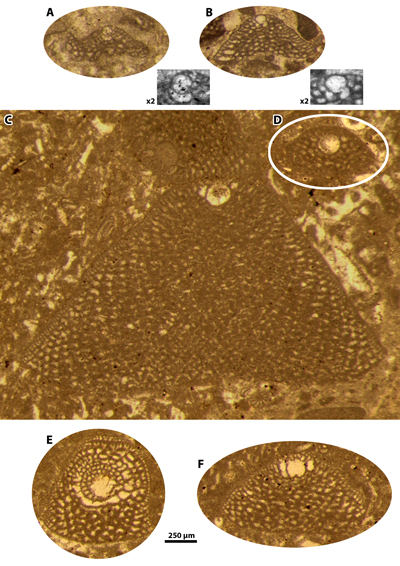
Click on thumbnail to enlarge the image.
Figure 8: A-B: Slightly oblique and axial sections of Praeorbitolina cormyi , 1964, from the "Orbitolina Beds", directly above the Jezzinian section at Jezzine, thin-section JEZh; C-D: Axial and slightly oblique sections of Palorbitolina lenticularis (, 1805) from Jezzinian strata, East Ain Dara, thin-section EAD38; E-F: Tangential and axial sections of Palorbitolina lenticularis (, 1805) from Jezzinian strata, East Ain Dara, thin-section EAD 68; scale bar = 250 µm (or 500 µm for "x2").
Our micropaleontological inventory is still ongoing.
Lebanese fossil assemblages and those of the Persian Gulf share microfossils in common, among which are:
i) Salpingoporella dinarica, only known from the Southern Tethys,
ii) Montseciella arabica, rare or missing outside this domain,
iii) Choffatella decipiens and iv) Palorbitolina lenticularis, which are cosmopolitan,
v) Rectodictyoconus giganteus , 1964, the occurrence of which is poorly documented everywhere.
Salpingoporella dinarica and Choffatella decipiens have long ranges. Palorbitolina lenticularis, which spans most of Barremian - Bedoulian, has a medium range. Only two of these species have short ranges: Montseciella arabica, which characterizes the Late Barremian and extends into the earliest Bedoulian, and Rectodictyoconus giganteus, which is mostly early Bedoulian in age (Deshayesites oglanlensis Zone, see et al., 2010 [3]). In conclusion, based on the microfossil contents, the Jezzinian Alloformation/Regional Stage spans a rather short time interval corresponding to the transition of the Barremian to the Bedoulian.
vi) Praeorbitolina cormyi is found in the first layers above the Jezzinian section at Jezzine. According to and (2013), this species is not reported from strata younger than the Deshayesi ammonite Zone, i.e., not younger than the late Bedoulian, a datum which again is consistent with our interpretation.
The micropaleontological associations in Lebanon can be compared with those of the Persian Gulf, on the eastern side of the Arabian plate. According to the synthetic stratigraphic schema for Abu Dhabi (, 2000, 2008; et al., 2003, 2011; & , 2011; & , 2013), which is also valid for Oman and Qatar, biostratigraphically significant species range throughout lithostratigraphic units:
i) Montseciella arabica occurs in the Kharaib Formation from Kharaib 1 to Kharaib 3 intervals;
ii) Rectodictyoconus giganteus is restricted to the Kharaib 3 interval;
iii) Choffatella decipiens spans the interval from the Lekhwair to the Bab formations (encompassing the Kharaib Formation);
iv) Palorbitolina lenticularis spans the whole Kharaib - Shu'aiba formations interval;
v) Salpingoporella dinarica was found in the uppermost part of the Lekhwair Formation and most of the Kharaib (except for Kharaib 2), the Hawar and the Shu'aiba formations. It is also known much lower in the series, i.e., from the Bu Haseer Formation (Tithonian-Berriasian transition according to , 2002);
vi) Involutina hungarica is reported as "Hensonina lenticularis" in the uppermost part of the Lekhwair Formation and most of the Kharaib (except for Kharaib 2) ( et al., 2003);
vii) and, in Oman, Praeorbitolina cormyi first occurs in the Shu'aiba ( & , 1994: Pl. 10.1, fig. 5; Pl. 10.1, fig. 6 under "Orbitolina (Mesorbitolina) lotzei").
The distribution of Montseciella arabica led us to correlate the Jezzine type-section
(Log ![]() ) in Lebanon with the Kharaibian Regional Stage of the Persian Gulf
(Fig. 9
) in Lebanon with the Kharaibian Regional Stage of the Persian Gulf
(Fig. 9 ![]() ) and to exclude both the Hawarian and the Shuaibaian: the Jezzinian "falls" into the Kharaib interval.
) and to exclude both the Hawarian and the Shuaibaian: the Jezzinian "falls" into the Kharaib interval.
The Kharaib in Abu Dhabi was first mentioned by (1953, unpublished report), then published by & (1975) and changed in 'status' to the "Kharaibian Regional Stage" by (2008). The occurrence of Rectodictyoconus giganteus, which needs to be better documented, would even narrow the interval to solely the Kharaib 3 sequence but because there are two sequences in the Jezzinian we shall assume that it is equivalent to the upper Kharaibian of Abu Dhabi (i.e., Kharaib 3-4).
The Kharaibian Regional Stage was correlated with a North-Tethyan scale in SW Europe (, 2000; et al., 2003). The time range corresponding to this South-Tethyan unit is equivalent to sequences Ba3 to Bd1 of et al. (2007) as in et al. (2003), not Ba1-Ba4 as in (2000), i.e., Late Barremian-early Bedoulian interval. Accordingly, it can be indirectly correlated with the Moutonianum-Oglanlensis ammonite zones.
If we take into consideration the occurrence of Rectodictyoconus giganteus in the Jezzinian itself, we can narrow the correlation to the sequences Kharaib 3 and Kharaib 4, or its North-Tethyan equivalent Ba5 and Bd1 of et al. (2007).
On another side, our macrofossil finds, more specifically that of the irregular echinoid Heteraster oblongus, a marker of the latest Barremian - early Bedoulian in southeastern Europe, below and inside the cliff (i.e., in the Jezzinian), and that of the ammonite Cheloniceras cornuelianum, above the cliff (in the basal Cardium Beds), confirm our age ascription for the newly defined Jezzinian Regional Stage.
In Lebanon, the occurrence of Praeorbitolina cormyi in the first strata above the
Jezzinian, i.e., at the base of the Cardium
Beds, and those of Montseciella arabica and Rectodictyoconus giganteus in the Jezzinian itself
suggest that the upper discontinuity of the regional stage might correspond to a hiatus
(Fig. 9 ![]() ) equivalent at least to the duration of the Hawarian (and possibly that of the
"ghost" sequence Kharaib 5). With respect to et al.
(2007), the hiatus
would then encompass at least the
sequence Bd3 (and possibly that of the
"ghost" sequence equivalent, Bd2), i.e., parts of the Weissi
and Deshayesi ammonite zones (and possibly the whole Weissi Zone with parts of
both the Oglanlensis and the Deshayesi zones).
) equivalent at least to the duration of the Hawarian (and possibly that of the
"ghost" sequence Kharaib 5). With respect to et al.
(2007), the hiatus
would then encompass at least the
sequence Bd3 (and possibly that of the
"ghost" sequence equivalent, Bd2), i.e., parts of the Weissi
and Deshayesi ammonite zones (and possibly the whole Weissi Zone with parts of
both the Oglanlensis and the Deshayesi zones).
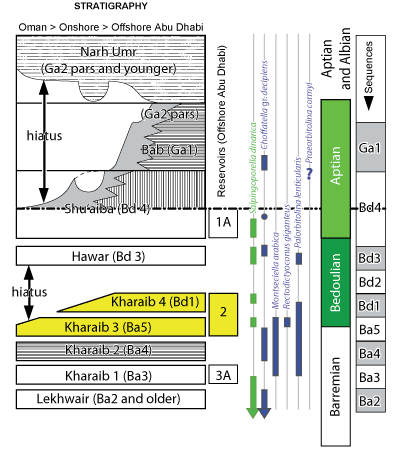
Click on thumbnail to enlarge the image.
Figure 9: Stratigraphic log of Abu Dhabi with the Southern and Northern Tethyan correlations (modified from & , 2013) and the stratigraphic distribution of some microfossils. The yellow highlighted zone represents the Jezzinian correlating with the Kharaib 3 and Kharaib 4, and equating with the Ba5 and Bd1 of et al. (2007).
An holostratigraphic re-evaluation of the "Falaise de " led us to redefine it, not as in 's times as a facies-driven "Formation" but, as a 'time-constrained' stratigraphic unit, i.e., an unit bounded by two discontinuities: the Jezzinian Regional Stage, UBU or Alloformation (in our understanding these three terms represent slightly similar concepts). On the basis of biostratigraphic information (mostly derived from micropaleontological data, but duly supplemented by some macropaleontological data) and through a holostratigraphic approach, the newly defined Jezzinian should fall in a time interval corresponding to the latest Barremian - early Bedoulian. The upper boundary may locally correspond to a significant intra-Bedoulian hiatus (i.e., spanning at least parts of the Weissi and Deshayesi ammonite zones). As currently understood, the lower boundary is probably intra-latest Barremian. Consequently the underlying strata, which yield charophyte remains ( & , 1968) or amber with biological inclusions, mostly insects (, 1997, 2000, 2007, 2012; et al., 2010), are slightly older than previously thought ( & , 1968; et al., 2003), i.e., Barremian, not Bedoulian nor Aptian auct.
Forthcoming investigations on this unit and on both its underlying (e.g., "Mréjatt Cliff") and overlying (e.g., " Cliff") units will probably help to confirm and refine these preliminary results.
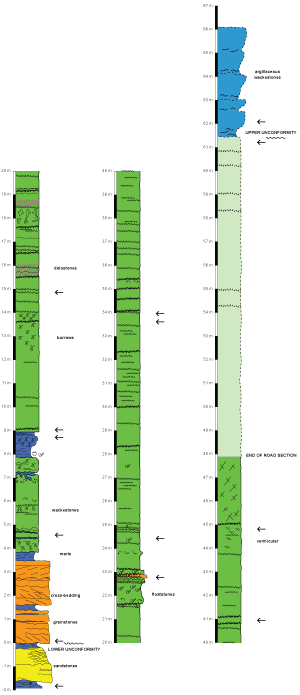
Click on thumbnail to enlarge the image.
Log: The
type-section at Jezzine, on the side of the main road at the entrance to the town.
It was measured using a 's staff. There it is more than 48 m thick but it
reaches some 61.5 m (estimated) in the nearby cliff section at Wadi Jezzine
(Fig. 3 ![]() ).
).
We would like to thank the CNRSL (National Council for Scientific Research-Lebanon) and the AUF (University Agency of the Francophony) for their financial support. This research is a contribution to the project Nº 30959NJ - PHC CEDRE 2014, supported by of the research project of Hubert-Curien Partnership program (PHC) CEDRE; implemented in Lebanon and France by the Ministry of Foreign Affairs (Ministère des Affaires étrangères, MAE) and the Ministry of Higher Education and Research (Ministère de l'Enseignement Supérieur et de la Recherche, MESR) led by Bruno (France) and Dany (Lebanon). This paper is also a contribution of the team project "Biodiversity: Origin, Structure, Evolution and Geology" led by Dany at the Lebanese University.
A part of the studied material (ammonites and echinoids) is registered with MHNUL numbers in the collections of the Muséum d'Histoire naturelle, Université Libanaise, Fanar - El-Matn (Lebanon); another part, consisting of the thin sections, is deposited with LPB numbers in the collections the Département des Sciences de la Terre et de l'Univers, Université de Bretagne Occidentale, Brest (France).
Elements of this paper were first presented at the 9th International Symposium on the Cretaceous System ( et al., 2013). The first author (S.M.) acknowledges the financial support of UMR 6538 CNRS to attend this meeting. She is also grateful to Danielle and Isabelle for their support in the field, and to Rémy for having prepared one ammonite from Kfar Nabrakh (MHNUL 23655/0001). The Foundation "Carnets de Géologie" has provided financial support to the second author (B.G.) for his first mission to Beirut and Lebanon in September 2013. The first two authors (S.M. and B.G.) would like to acknowledge the support of the numerous ammonitologists who also shared with them views on the Lebanese material, namely Ottilia , Vyara , Didier , Robert , Miguel , Gérard , Marin , Mikheil , Jean-Louis , Antoine , Nasser Seyed , and Stéphane . We are also grateful to Bernard for having prepared the thin sections with Montseciella arabica and identified the echinoderm fauna. Finally, Jean-Pierre , Pierre and Robert W. are thanked for their detailed critical reviews of the original manuscript; R.W. also helped polishing the English text.
S., R. & H. (1995).- Les fossiles du Liban. Guide pratique.- Mèouchy & Zakaria, Beyrouth, 86 p.
S., R. & H. (1997).- Fossils of Lebanon. Visual guide.- Studies in Natural Sciences, Beirut, vol. XXI, 80 p. [English version] + 91 p. [Arabic version] (XXXI Pls.).
G. (1930).- Sur un Agria du Liban.- Compte-Rendu de l'Association Française pour l'Avancement des Sciences, Paris, 3e Groupe - Sciences naturelles, (8e Section - Géologie et Minéralogie), 54e session (Alger, 1930), p. 149-151.
D. (1997).- Lebanese Amber.- Meganeura, Strasbourg, vol. 1, p. 26-27.
D. (2000, unpublished).- L'ambre mésozoïque du Liban.- Ph.D., Université Paris Sud - Paris XI, Orsay, 164 p. (+ annexes).
D. (2007).- Preservation and accumulation of biological inclusions in Lebanese amber and their significance.- Comptes rendus Palevol, Paris, vol. 6, nº 1-2, p. 151-156.
D. (2012).- Lebanese amber: a "Guinness Book of Records".- Annales Universitatis Paedagogicae Cracoviensis, Kraków, Folia 111, p. 44-60.
D., R. & F. (2010).- Chapter 14 Lebanese amber. In: D. (ed.), Biodiversity of fossils in amber.- Siri Scientific Press, Castleton, p. 271-298.
D., A. & R. (2003).- Use of amber fossil inclusions in palaeoenvironmental reconstruction, dating and palaeobiogeography. In: Fossil insects.- Acta Zoologica Cracoviensa, vol. 46, supplement, p. 393-398.
P.W. & H.S. (1971).- Calcareous algae from the Jurassic and Cretaceous of Lebanon.- Micropaleontology, New York, vol. 17, nº 4, p. 411-433.
J.-P., P., M.A., R. & M. (1978).- Les algues Dasycladales du Jurassique et du Cretacé.- Géobios, Villeurbanne, Mémoire spécial, nº 2, 330 p.
C.-I. (1847).- Lettre du Liban.- Bulletin de la Société géologique de France, Paris, vol. 2, nº 5, p. 12-17. Online at http://archive.org/stream/bulletindelasoc69frangoog#page/n18/mode/1up
R. & B. (2011).- Aptian ammonites of Abu Dhabi (United Arab Emirates).- Carnets de Géologie [Notebooks on Geology], Brest, Letter CG2011/04 (CG2011_L04), p. 117-135.
N., M.A. & R. (2006).- Salpingoporella, a common genus of Mesozoic Dasycladales (calcareous green algae).- Revue de Paléobiologie, Genève, vol. 25, nº 2, p. 457-517.
A. & R. (1999).- Montseciella, a new orbitolinid genus (Foraminiferida) from the Uppermost Hauterivian - Early Barremian of SW Europe.- Treballs del Museu de Geologia de Barcelona, vol. 8, p. 5-23.
A. & R. (2013).- The Praeorbitolina/Palorbitolinoides association: an Aptian biostratigraphic key-interval at the southern margin of the Neo-Tethys. In: P., B. & M. (eds.), Special issue: Spatial patterns of change in Aptian carbonate platforms and related events.- Cretaceous Research, London, vol. 39, p. 70-77.
B., J., M., du R., R., S., E., R., A., D., B., J. & M. (2007).- Dating and progradation of the Urgonian limestone from the Swiss Jura to South-East France.- Zeitschrift der Deutschen Gesellschaft für Geowissenschaften, Stuttgart, vol. 158, nº 4, p. 1025-1062.
B., M., R., J. & B. (2013).- Mapping the rise and demise of Urgonian platforms (Late Hauterivian - Early Aptian) in southeastern France and the Suisse Jura. In: P., B. & M. (eds.), Special issue: Spatial patterns of change in Aptian carbonate platforms and related events.- Cretaceous Research, London, vol. 39, p. 29-46.
L., A., M. & E. (2014).- Involutina hungarica (, 1952) from the Albian Tethys: Architecture, palaeoenviroment and palaeobiogeography.- Cretaceous Research, London, vol. 51, p. 266-273.
P. (1975, unpublished).- Utilisation de méthodes quantitatives en paléoécologie. Application à l'étude des microfaciès du Barrémien terminal et du Bédoulien de l'Estremadura (Portugal).- Thèse de 3éme Cycle, Université Paul Sabatier, 120 p. (3 Pls.).
K. (1886).- Libanon : Grundlinien der physischen Geographie und Geologie von Mittel-Syrien.- Hölder, Wien, X + 412 p.
H. (1910).- Études sur les rudistes : rudistes de Sicile, d'Algérie, d'Égypte, du Liban et de la Perse.- Société géologique de France, (Paléontologie), Paris, Mémoire nº 41, t. XVIII, fasc. nº 1, 84 p. (7 Pls.).
H. (1913).- Sur quelques rudistes du Liban et sur l'évolution des Biradiolitinés.- Bulletin de la Société géologique de France, Paris, vol. 4, p. 409-421.
L. (1934).- Première partie. La carte géologique au millionième de la Syrie et du Liban In: Présentation d'une carte géologique générale au 1:1.000.000e de la Syrie et du Liban.- Revue de Géographie physique et de Géologie dynamique, Paris, t. VI (1933), fasc. 4, p. 269-318 (2 maps, 2 logs, Pls. XV-XXIV).
L. (1947).- Aperçu de géographie physique sur le Liban, l'Anti-Liban et la Damascène.- Haut Commissariat de la République française en Syrie et au Liban, Notes et Mémoires, Paris, (Section d'études géologiques), vol. 4, p. 191-226.
L. (1955).- Notice explicative de la Carte géologique du Liban au 200.000ème.- Ministère des Travaux Publics, Beyrouth, 74 p. (30 Pls.).
L. (1963).- A. Liban et Syrie. Chaîne des grands massifs côtiers et confins à l'Est. In: L. (ed.), Liban, Syrie, Jordanie.- Lexique Stratigraphique International, Paris, vol. III, Asie, fasc. 10 c1, p. 7-155.
L. & H. (1937).- Révision de la stratigraphie du Crétacé du Liban. In : L. (éd.), Contributions à l'étude géologique de la côte libano-syrienne.- Haut-Commissariat de la République Française en Syrie et au Liban, Notes et Mémoires, Paris, (Section d'études géologiques), tome II, p. 43-85.
G. (1968).- Three new Tethyan Dasycladaceae (Calcareous Algae).- Paleontology, London, vol. 11, nº 4, p. 491-497 (Pls. 93-95).
O. (1878).- Aus dem Orient: Geologische Beobachtungen am Libanon.- Schweizerbart, Stuttgart, 278 p.
L. & J. (1968).- Une flore de charophytes du Crétacé inférieur du Proche-Orient.- Naturalia monspeliensia, (sér. Bot.), fasc. 19, p. 47-56 (Pls. I-IV).
B. (1994).- The genus Actinoporella ( in , 1881) and its representatives. A review.- Proceedings of the International Symposium and Field-Meeting "Alpine Algae '93".- Beiträge zur Paläontologie, Vienna, nº 19, p. 113-127.
B. (2000).- Lower Cretaceous stratigraphy of Abu Dhabi and the United Arab Emirates - A reappraisal.- The 9th Abu Dhabi International Petroleum Exhibition & Conference, Conference Proceedings, Abu Dhabi, ADIPEC 0918, p. 526-535.
B. (2002).- Algues Dasycladales, nouvelles ou peu connues, du Jurassique supérieur et du Crétacé inférieur du Moyen-Orient. In: I.I. & S. (eds.), Research advances in calcareous algae and microbial carbonates.- Proceedings of the 4th IFAA Regional Meeting (Cluj-Napoca, August 29 - September 5, 2001), Presa Universitara Clujeana, p.103-113.
B. (2008).- Holostratigraphy of the Kahmah regional Series in Oman, Qatar, and the United Arab Emirates.- Carnets de Géologie [Notebooks on Geology], Brest, Article 2008/07 (CG2008_A07), 33 p.
B., A.S., R., S.K. & R. (2003).- New insight on the stratigraphy of the "Upper Thamama" in offshore Abu Dhabi (U.A.E.).- Carnets de Géologie [Notebooks on Geology], Maintenon, Article 2003/05 (CG2003_A05), 17 p.
B. & R. (2013).- New stratigraphic data on the Aptian of the Persian Gulf. In: P., B. & M. (eds.), Special issue: Spatial patterns of change in Aptian carbonate platforms and related events.- Cretaceous Research, London, vol. 39, p. 170-182.
B., R. & B. (2011).- New data on the Hawar, Shu'Aiba, Bab, and Sabsab regional stages of the Lower Cretaceous in the United Arab Emirates and in Oman.- Boletín del Instituto de Fisiografía y Geología, Rosario, vol. 79-81, p. 11-13.
B., R., B., M., J., G. & P. (2014).- Refurbishing the Urgonian biostratigraphy: A key section at L'Estellon, Drôme, France. In: R., J., J.C. & S. (eds.), STRATI2013. First International Congress on Stratigraphy at the cutting edge of stratigraphy.- Springer, Heidelberg, p. 1095-1097.
B., B., M., R., J., G. & P. (2013).- L'Estellon (Baronnies, France), a "Rosetta Stone" for the Urgonian biostratigraphy.- Carnets de Géologie [Notebooks on Geology], Brest, Article CG2013/04 (CG2013_A04), p. 163-207.
B. & R. (1993).- Inventaire des Algues Dasycladales fossiles. IIº partie - Les Algues Dasycladales du Jurassique et du Crétacé.- Revue de Paléobiologie, Genève, vol. 12, nº 1, p. 19-65.
F. (1942).- La géologie d'une partie du Liban Sud.- Thesis, Dr in de Wis- en Natuurkunde aan de Rijksuniversiteit Groningen; Leidsche Geologische Meddedeelingen, vol. XII, fasc. 2, p. 251-470.
F.R.S. (1947).- XLI.- Foraminifera of the genus Trocholina in the Middle East.- The Annals and Magazine Natural History, London, (11th series), vol. xiv, nº 115, p. 445-459 (Pls. XI-XIII).
F.R.S. (1948).- Larger imperforate foraminifera of south-western Asia, Families Lituolidae, Orbitolinidae and Meandropsinidae.- Monograph of the British Museum of Natural History, London, 127 p.
M., A. & A. (1980).- Les algues du Crétacé Inférieur des séries de type Bey Daglari (Taurides Occidentales, Turquie).- Bulletin of Mineral Research and Exploration Institute of Turkey, Ankara, vol. 91, p. 76-88 (Pls. I-VI).
A. & H. (1937).- Nouvelle contribution à l'étude des Échinides de la Syrie et du Liban. Première partie. Crétacé. In : L. (éd.), Contributions à l'étude géologique de la côte libano-syrienne.- Haut-Commissariat de la République Française en Syrie et au Liban, Notes et Mémoires, Paris, (Section d'études géologiques), tome II, p. 137-164 (Pls. V-VII).
P. de (1887).- Notes pour servir à l'étude des Échinodermes. II.- Recueil zoologique suisse, Genève, tome IV, (1ère serie), p. 365-407 (Pls. XV-XVIII).
S., B. & D. (2013).- Questioning the age and correlations of the Cretaceous Formation Falaise de in Lebanon.- 9th International Symposium on the Cretaceous System, Ankara (September 1-5), Abstract Book, p. 8.
S., B. & D. (2014).- First record of Harlanjohnsonella annulata in & , 1993, non 1968, a Triploporellacean alga in Upper Barremian-lowermost Bedoulian strata of Lebanon.- Acta Palaeontologica Romaniae, Cluj Napoca, vol. 10, nº 1-2, p. 47-60.
J.-P. (1995).- Lower Cretaceous rudist biostratigraphy of southern France, a reference for Mesogean correlations.- Revista Mexicana de Ciencias geologicas, Mexico, vol. 12, p. 236-256.
J.-P. & M. (2014, in press).- Evolution of the rudist bivalve Agriopleura (Radiolitidae, Hippuritida) from the Mediterrnean region.- Palaeontology, London.
M., B. & G. (2011).- The Aptian Stage: Back to fundamentals.- Episodes, Bangalore, vol. 34, nº 3, p. 148-156.
M. & P. (1975).- Les "Mésorbitolines" : révision taxinomique, importance stratigraphique et paléobiogéographique.- Bulletin de la Société géologique de France, Paris, (7ème série), tome 17, nº 5, p. 828-842.
M., S. & G. (1998).- Rappel historique sur l'étage Aptien et ses stratotypes.- Géologie méditerranéenne, Marseille, t. XXV, nº 3-4, p. 5-9.
M.A. & A. (1999).- International stratigraphic guide - An abridged edition.- Episodes, Bangalore, vol. 22, nº 4, p. 255-271.
R. (1995).- Contribution to the study of Cretaceous biostratigraphy of Zlatibor Mountain.- Radovi Geoinstituta, Beograd, vol. 31, p. 17-30 (in Serbo-Croatian, with English abstract).
R. & F. (2010).- Observations on Dissocladella annulata (, 1993) nov. comb. (calcareous algae, Dasycladales) from the Cenomanian of west Serbia.- Geoloki anali Balkanskoga poluostrva, Beograd, vol. 71, p. 53-71.
S., J., R. & R. (2014, in press).- Taxonomy, phylogeny, and functional morphology of the foraminiferal genus Involutina.- Acta Palaeontologica Polonica, Varsaw.
P. (1970).- Contribution à la connaissance du Crétacé basal au Liban.- Revue de Micropaléontologie, Paris, vol. 12, nº 4, p. 224-233.
P. (1972).- Le Crétacé inférieur et moyen du bord occidental du Jabal Sannine (Liban).- Notes et Mémoires du Moyen-Orient, Paris, t. XII, p. 217-226.
F., I.I., K. & B. (2013).- Praeorbitolina claveli n.sp. (benthic Foraminifera) from the Lower Aptian sensu lato (Bedoulian) of Central Iran.- Carnets de Géologie [Notebooks on Geology], Brest, Letter 2013/04 (CG2013_L04), p. 255-272.
F. & W. (1990).- Involutina hungarica () from allochthonous Urgonian limestones of the Northern Calcareous Alps and remarks on the genus Hensonina & , 1974.- Beiträge zur Paläontologie von Österreich, Wien, nº 16, p. 145-153.
R. (1979).- Les Orbitolines de l'Aptien : Définition, origine et évolution.- Géobios, Villeurbanne, Mémoire Spécial, nº 3, p. 289-299.
R., F.S.P. van, A., D., B., A. & B. (2010).- Revised orbitolinid biostratigraphic zonation for the Barremian - Aptian of the eastern Arabian Plate and implications for regional stratigraphic correlations.- GeoArabia, Manama, vol. 1, p. 49-96.
R. & M. (1985).- Les grands foraminifères du Crétacé Moyen de la région méditerranéenne.- Géobios, Villeurbanne, Mémoire Spécial, nº 7, p. 1-140.
M. (1952).- Az urkúti mangánösszlet fedőrétegének Foraminiferái.- Földtani Közlöny, Budapest, évf. 82, sz. 10-12, p. 386-396 (Pl. XIX).
M.D., J.E. & R.W. (2000).- Orbitolinids from Cretaceous sediments of the Middle East - a revision of the F.R.S. and Associates Collection. In: M.B., M.A. & C.W. (eds.), Proceedings of the 5th International Workshop on Agglutinated Foraminifera.- Foundation Special Publication, Krakow, vol. 7, p. 411-437.
P.W. & J.-P. (2000).- Synoptic guide to the Lower Cretaceous rudist bivalves of Arabia.- Society of Economic Paleontologists and Mineralogists, Special Publication, Tulsa, vol. 69, p. 89-99.
B. (1996).- Taxonomic review of some Barremian and Aptian calcareous algae (Dasycladales) from the Dinaric and Adriatic Karst regions of Croatia.- Geologia Croatica, Zagreb, vol. 49, nº 1, p. 1-79.
W. & A.J. (1975).- Qatar peninsula.- Lexique stratigraphique international, Paris, (Asie), vol. III, fasc. 10 b 3, p. 7-88.
B. (1965, unpublished).- Contribution à l'étude des grès de base du Liban.- Thèse 3º cycle, Université de Paris, Centre d'Orsay, 89 p. (29 Pls.).
B. (1972).- Le "grès de base" crétacé du Liban : étude stratigraphique et sédimentologique.- Notes et Mémoires sur le Moyen-Orient, Paris, tome XII, p. 187-215
C.D. (1983).- A Revision of the Lower Cretaceous Stratigraphy of Lebanon.- Geologische Rundschau, Stuttgart, Band 72, Heft 1, p. 377-388.
W. & H. (1994).- Orbitolinid biostratigraphy of the Shuaiba Formation (Aptian), Oman - implications for reservoir development. In: M.D. (ed.), Micropalaeontology and hydrocarbon exploration in the Middle East.- British Micropalaeontological Society Publications Series, Chapman & Hall, London, p. 221-234.
G. (1926).- Géologie du Liban.- Henry Barrère, Paris, 165 p.
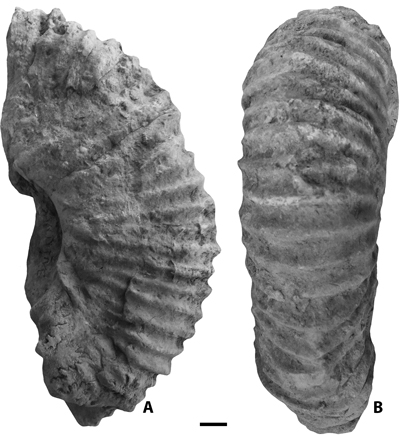
Click on thumbnail to enlarge the image.
Plate 1: Lateral view (A) and ventral view (B) of Cheloniceras sp. (MHNUL 22797/0006), lowermost Cardium Beds, Kanat Bakich. Scale bar = 1 cm.
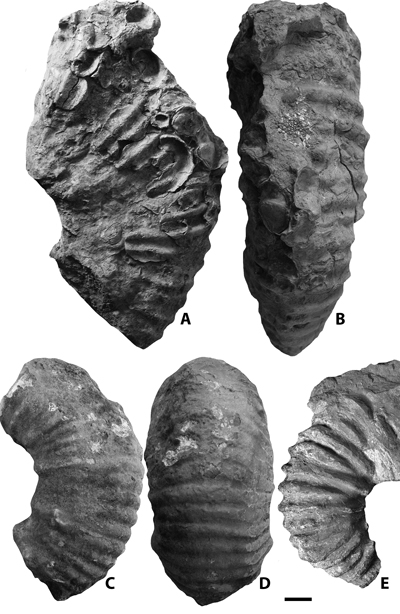
Click on thumbnail to enlarge the image.
Plate 2: A-B: Lateral view (A) and ventral view (B) of Cheloniceras sp. (MHNUL 22797/0002), lowermost Cardium Beds, Kanat Bakich; C-D: Lateral view (C) and ventral view (B) of Cheloniceras cornuelianum (, 1841) (MHNUL 22797/0001), lowermost Cardium Beds, Kanat Bakich; E: Lateral view of a Cheloniceras cornuelianum (, 1841) (MHNUL 23655/0001), lowermost Cardium Beds, Kfar Nabrakh. Scale bar = 1 cm.
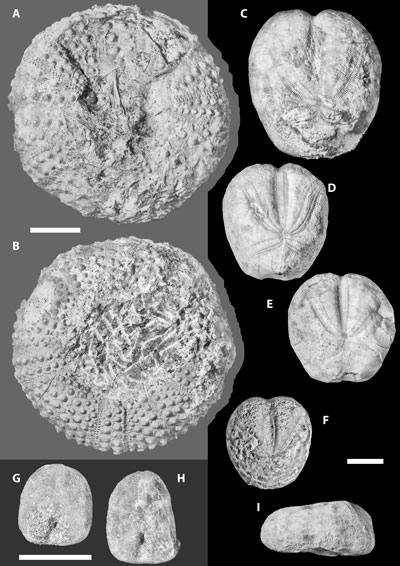
Click on thumbnail to enlarge the image.
Plate 3: A-B: Apical view (A) and oral view (B) of Tetragramma malbosi ( & , 1846), Cardium Beds, Zaarour (MHNUL 22733/0001), Leg. 12/09/2013; C-E: Apical views and I: Left side view of Heteraster oblongus (, 1821), lower Jezzinian; C and E: Kanat Bakich; C (MHNUL 22797/0002) and E (MHNUL 22797/0003); D and I: Kfardebiane (MHNUL 25439/0001); F: Apical view of Heteraster delgadoi (, 1888), Cardium Beds, Kanat Bakich (MHNUL 22797/0001). G-H: Apical views of Nucleopygus roberti (A. , 1848), uppermost strata of "Grès de Base", Daychounieh; G (MHNUL 37321/0001) and H (MHNUL 37321/0002). Material identification by B. . All scale bars = 1 cm.
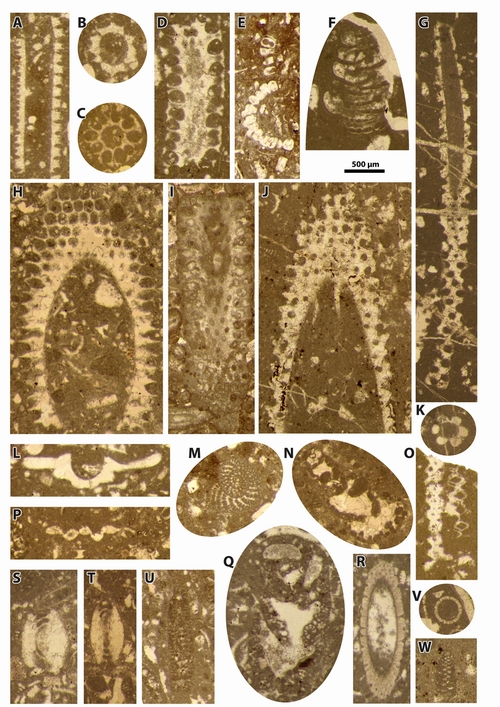
Click on thumbnail to enlarge the image.
Plate 4: Microfossils, calcareous algae and benthic foraminifers, from the Jezzinian interval. A: Axial section of Salpingoporella hasi et al., 1977, Maarab, thin-section MEB44; B: Transverse section of Salpingoporella hasi et al., 1977, Maarab, thin-section MEB44; C: Transverse section of Montiella elitzae (, 1971), East Ain Dara, thin-section EAD18; D: Subaxial section of Montiella elitzae (, 1971), East Ain Dara, thin-section EAD19; E: Oblique sections of Genotella pfenderae ( & , 1962), Ain-El-Bnaya, thin section VO4; F: Subaxial section of Praechrysalidina infracretacea , 1979, Maarab, thin-section MEB74; G: Longitudinal section of Salpingoporella muehlbergii (, 1902), Maarab, thin-section MEB73; H: Oblique section of a new species of Triploporellaceae, East Ain Dara, thin-section EAD18; I: Longitudinal section of Suppiluliumaella polyreme , 1968, Aarbet Kozhaya, thin section AAR 16.4; J: Oblique section of Harlanjohnsonella annulata , 1968, El Sheaybeh, thin-section VO15; K: Transverse section of Salpingoporella muehlbergii (, 1902), Maarab, thin-section MEB73; L: Oblique section of a verticil of Actinoporella gr. podolica (, 1878), East Ain Dara, thin-section EAD19; M: Equatorial section of Choffatella decipiens , 1905, Maarab, thin-section MEB44; N: Longitudinal-subaxial section of Lituola cf. inflata , 1944, Ain-El-Bnaya, thin-section VO36; O: Tangential sections of Salpingoporella muehlbergii (, 1902), Maarab, thin-section MEB73; P: Tangential section of a verticil of Actinoporella gr. podolica (, 1878), East Ain Dara, thin-section EAD20; Q: Longitudinal-subaxial section of Buccicrenata hedbergi (, 1953), East Ain Dara, thin-section EAD20; R: Oblique section of Salpingoporella dinarica (, 1959), East Ain Dara, thin-section EAD19; S: Oblique section of Involutina hungarica (, 1952), East Ain Dara, thin-section EAD38; T: Axial section of Involutina hungarica (, 1952), East Ain Dara, thin-section EAD38; U: Subaxial section of Choffatella decipiens , 1905, East Ain Dara, thin-section EAD18; V: Transverse section of Salpingoporella dinarica (, 1959), Maarab, thin-section MEB73; W: Pseudotextulariella scarsellai (, 1964), Ain-El-Bnaya, VO74. Scale bar = 500 µm.
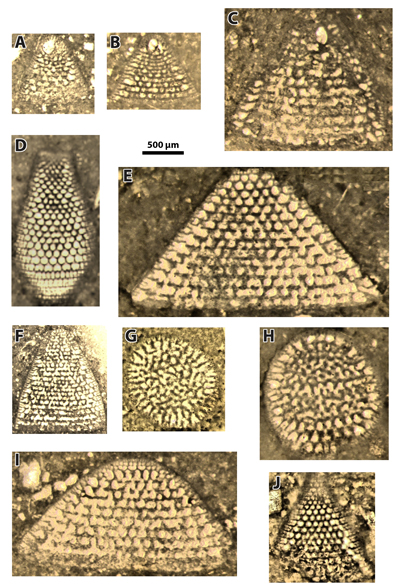
Click on thumbnail to enlarge the image.
Plate 5: Montseciella arabica. Deir Kreim, Ghosta. A: Axial section, thin section Krim-4a; B: Axial section, thin section Krim-6a; C: Axial section, thin section Krim-2b; D: Oblique section, thin section Krim-3b; E: Subaxial section, thin section Krim-3a; F: Subaxial section, thin section Krim-2a; G: Subtransverse section, thin section Krim-4c; H: Subtransverse section, thin section Krim-1b; I: Oblique section, thin section Krim-2c; J: Subaxial section, thin section Krim-6b. Thin sections prepared by B. . Scale bar = 500 µm.
et al. (2011) recommended a new status for the Aptian substages, raising them to the rank of genuine stages. Accordingly the lower Aptian sensu anglico et gallico would equate with the historical Bedoulian; the Gargasian (middle Aptian sensu gallico) should be treated as a junior synonym of the historical Aptian auct. [there are no Bedoulian strata in Apt, nor in Gargas]. At La Bédoule, in the historical stratotypic section of the Bedoulian, the boundary between the Bedoulian and the Aptian auct. is located on top of bed 170 ( et al., 2011).
et al. (2010: fig. 18, "Bab Basin" column) present selected data from a well offshore Abu Dhabi (, 2000, 2008; et al., 2003): the ranges of two species only, Eopalorbitolina transiens and Montseciella arabica, remain whereas those of three more species, Palorbitolina lenticularis, P. cf. ultima and Rectodictyoconus giganteus, were omitted. In the same figure, the Kharaib is ascribed a Barremian age, excluding a Bedoulian age for its upper part, in blatant contradiction of the ranges of the fossil contents reported in the referenced papers.